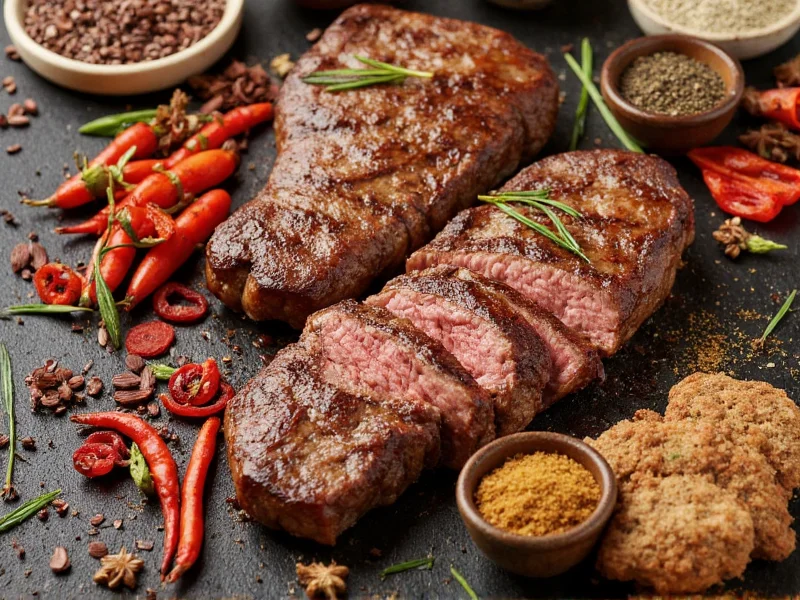Choosing the right spices transforms ordinary steak into a culinary masterpiece. While personal preference plays a role, certain spices consistently enhance beef's natural flavors through chemical interactions with proteins and fats. The Maillard reaction—responsible for that perfect sear—works synergistically with specific compounds in spices to create complex flavor profiles that elevate your steak beyond basic seasoning.
Essential Steak Spices and Their Flavor Science
Salt isn't just for seasoning—it alters meat's protein structure, improving moisture retention and tenderness. Coarse varieties like kosher salt or Maldon sea salt provide better control than fine table salt. Freshly cracked black pepper delivers volatile compounds that complement beef's umami notes. Garlic powder offers consistent flavor without burning, unlike fresh garlic which can char at high searing temperatures.
Smoked paprika adds depth through guajillo and ancho chili compounds that harmonize with grilled flavors. Dried rosemary contains rosmarinic acid that enhances meat's natural savory qualities without overpowering. These foundational spices create what professional chefs call the 'flavor bridge'—compounds that connect meat's inherent tastes with additional seasoning elements.
Spice Pairings for Different Steak Cuts
| Steak Cut | Recommended Spice Profile | Application Timing |
|---|---|---|
| Ribeye (marbled) | Salt, pepper, garlic powder, thyme | Salt 60 min pre-cook; other spices 15 min pre-cook |
| Filet Mignon (lean) | Salt, cracked pepper, smoked paprika, onion powder | All spices applied 30 min pre-cook |
| Flank Steak (tough) | Salt, cumin, chili powder, garlic, acid (citrus/vinegar) | Marinate 2-4 hours with spices |
| NY Strip (balanced) | Salt, Tellicherry pepper, rosemary, mustard powder | Salt 45 min pre-cook; other spices 20 min pre-cook |
Advanced Seasoning Techniques
Professional kitchens use multi-stage seasoning for maximum impact. Begin with a 'dry brine'—rubbing salt onto the steak and refrigerating uncovered for 1-24 hours. This allows salt to penetrate deeply while drying the surface for superior searing. For thicker cuts, apply salt 60 minutes before cooking, then add other spices 15-20 minutes pre-cook to prevent burning.
Consider the 'flavor layering' technique: combine ground spices with a small amount of oil to create a paste that adheres better to the meat's surface. The oil helps hydrophobic flavor compounds in spices bond with the meat's fat content. For delicate herbs like tarragon or chives, add them after cooking to preserve volatile aromatic compounds that would otherwise dissipate during high-heat cooking.
Regional Spice Traditions
Different culinary traditions offer distinctive steak seasoning approaches. Argentinian chimichurri features parsley, oregano, and garlic with vinegar—applied after cooking. Japanese steak seasoning often includes sansho pepper and shichimi togarashi for subtle heat. Texas-style rubs emphasize coarse salt, black pepper, and sometimes coffee grounds for depth. French preparations frequently use herbes de Provence with thyme, savory, and marjoram.
Understanding these regional approaches helps you select spices based on your desired flavor profile. Mediterranean styles work well with leaner cuts, while bolder spice blends complement marbled steaks. The key is balancing the spice intensity with the steak's natural flavor—never letting seasoning overpower the meat itself.
Avoiding Common Seasoning Mistakes
Many home cooks make critical errors that diminish steak quality. Applying salt too close to cooking time draws out moisture, creating steam instead of sear. Using pre-ground spices loses 70% of volatile flavor compounds within weeks. Overcomplicating blends with too many spices creates flavor confusion rather than harmony.
Resist adding sugar-based rubs before high-heat cooking—they burn at temperatures needed for proper searing. Never use wet marinades as primary seasoning for premium cuts; they dilute surface flavors critical for Maillard reaction. And crucially, avoid seasoning immediately before cooking—give dry rubs at least 15 minutes to adhere and begin flavor integration.
Creating Your Signature Blend
Developing your personal steak seasoning allows culinary expression while respecting beef's integrity. Start with the classic 3:2:1 ratio (salt:pepper:garlic powder), then experiment with single additions. Add 1/4 teaspoon of smoked paprika for depth, or a pinch of dried thyme for earthiness. For special occasions, incorporate toasted cumin or coriander seeds ground fresh.
Store whole spices in airtight containers away from light, grinding only what you need. This preserves essential oils that provide complex flavor notes. Remember that less is often more—premium steak needs enhancement, not masking. The best steak seasoning should make you taste the beef first, with spices providing subtle supporting notes that emerge as you chew.
When should I apply salt to steak before cooking?
Apply coarse salt 45-60 minutes before cooking for cuts over 1.5 inches thick. This allows salt to penetrate while drawing surface moisture that evaporates, creating optimal conditions for searing. For thinner cuts, apply 15-20 minutes pre-cook to prevent excessive moisture release.
Can I use fresh herbs instead of dried for steak seasoning?
Fresh herbs work best when added after cooking, as high heat destroys delicate volatile compounds. If using before cooking, stick to hardy herbs like rosemary or thyme in small quantities. Dried herbs generally provide more concentrated flavor for direct application to raw steak due to their lower moisture content.
What's the ideal ratio for a basic steak seasoning blend?
The professional standard is a 3:2:1 ratio of coarse salt to freshly cracked black pepper to garlic powder. For a 1-inch thick steak, use approximately 3/4 teaspoon salt, 1/2 teaspoon pepper, and 1/4 teaspoon garlic powder. Adjust based on personal preference and steak thickness, but maintain this foundational balance for optimal flavor development.
Should I include sugar in my steak seasoning blend?
Avoid sugar in initial seasoning for high-heat cooking methods like grilling or pan-searing, as it burns at temperatures required for proper searing (above 350°F). If desired, add minimal sugar (1/8 teaspoon maximum) only for low-and-slow cooking methods, or apply sweet elements like caramelized onions after cooking.











 浙公网安备
33010002000092号
浙公网安备
33010002000092号 浙B2-20120091-4
浙B2-20120091-4